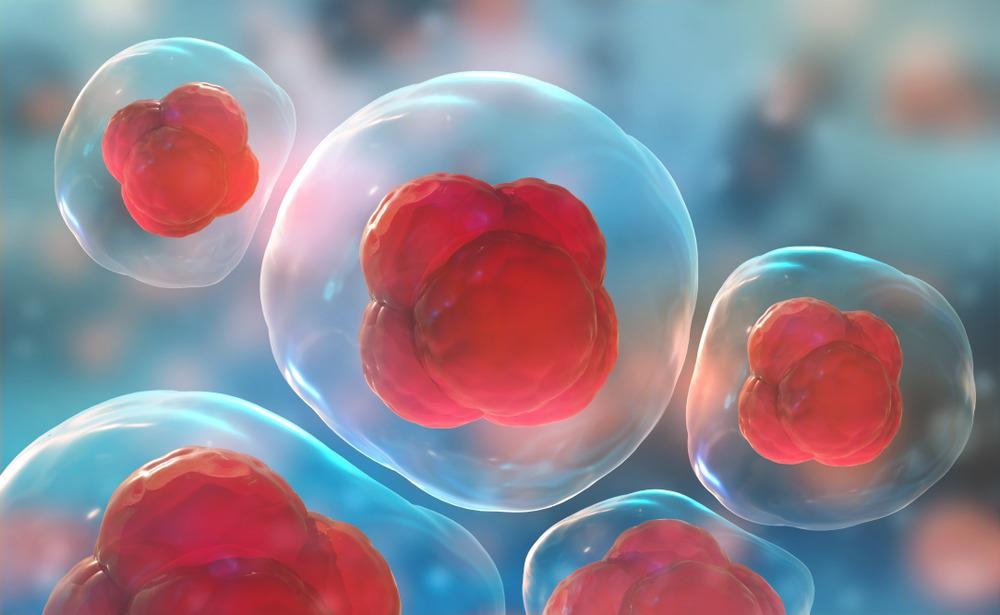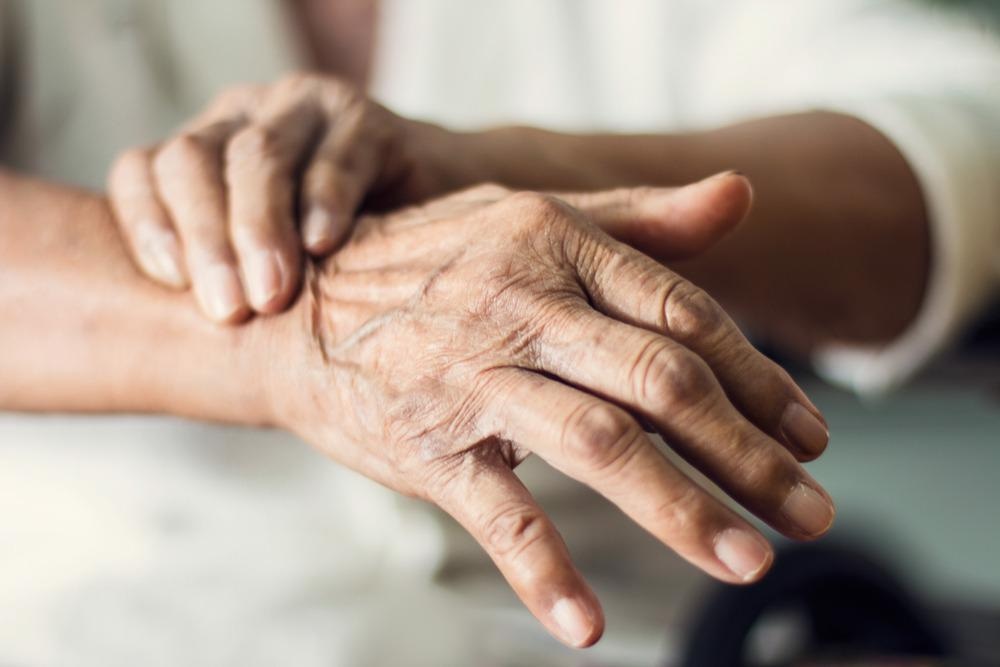Advancements in stem cell technology have facilitated the generation of inducible pluripotent stem cells (IPSCs), allowing for human diseases to be treated using patient-derived stem cells (PSCs). This bypasses the ethical concerns of using embryonic stem cells and addresses some problems associated with immune response.

Image Credit: Yurchanka Siarhei/Shutterstock.com
Issues around the scaling, differentiation, and maturity of PSCs continue to pose concerns. The repair of genetic mutations present in PSCs can present challenges: off-target effects and spontaneous tumorigenesis. Stem cell therapy could provide effective therapies in modeling and treating genetic disorders; the only current translational research performed using patient-derived stem cells was age-related macular degeneration (AMD).
Stem cells
The advent of effective protocols to direct somatic cells to de-differentiate into pluripotent stem cells by Yamanaka has provided new avenues of therapy for many non-druggable diseases. Pluripotent stem cells can then be differentiated down specific cell lineages to develop progenitor cells. These provide an alternative to transplantation from cadavers which are often limited and demand immunosuppressant regimens.
Many progenitor-cell types have been successfully cultured using specific growth and transcription factors such as hepatocytes. Many issues still surround these cells – immature phenotype, failure to recapitulate the anatomical architecture of the organ of interest, tumorigenesis, heterogeneity, and migratory issues from the site of injection.
Genetic modification is often needed with PSCs to repair associated aberrations; this presents concerns around off-target effects and tumorigenesis. The de-differentiation of somatic cells often utilizes lentiviral constructs to improve this process, eliciting concerns around tumorigenesis due to oncogenic transcription factors such as Myc.
Diabetes
Destruction of pancreatic β-cells due to Type 1 diabetes or acute pancreatitis presents opportunities for stem cell replacement therapies. The limited availability of cadaverous β-cell aggregates further potentiates PSCs as an alternative. Issues surround the delivery and the composition of this treatment.
Aggregates perform better in terms of survival and outputs such as insulin secretion. This has prompted an investigation into the encapsulation of islets to confer protection while facilitating the exchange of insulin and glucose. This has, so far, been unsuccessful in providing insulin independence. Autoimmunity continues to be a concern. PSCs are currently undergoing Phase I/II studies to investigate their efficacy as progenitor β-cells.
Neurodegenerative disorders: Parkinson’s and Huntington’s Disease
Both neurodegenerative disorders are associated with dysfunction in movement. The development of mid-brain dopaminergic neurons and medium spiny neurons from PSCs present exciting opportunities in the treatment of Parkinson’s and Huntington’s Disease respectively. Huntington’s Disease is associated with the generation of extended CAG repeats in the HTT gene.
PSCs derived from Huntington patients were genetically modified to correct associated aberrations and observed phenotypic reversal in vitro. This demonstrates the opportunity to utilize PSCs and gene editing tools such as CRISPR-Cas9 to restore function lost with disease.
One study has been successful in generating progenitor midbrain dopaminergic neurons and grafting them into an animal model, restoring motor function. Stringent genomic analysis of cell lineages was critical in this study to mitigate tumorigenesis. This study provides evidence for the potential of autologous stem cell replacement therapy.

Image Credit: PopTika/Shutterstock.com
Alzheimer’s Disease
An interesting lateral study utilized PSCs to target amyloid plaques in an animal model. The PSCs were differentiated into a modified form of macrophages which expressed neprilysin (an enzyme that targets αβ soluble amyloid oligomers). The modified cells were then transplanted into the 5XAD mice (AD mouse model).
The results demonstrated a reduced level of αβ in the interstitial brain fluid. This study highlights the potential to manipulate the immune system to address neurodegeneration using PSCs. Major issues surround the early detection of AD and whether αβ performs any basal function, potentially limiting its efficacy.
Muscular dystrophy
Duchenne Muscular Dystrophy is a muscle-wasting disease due to the lack of dystrophin at the sarcolemma of muscle fibers. Myoblasts and satellite cells are the two most recognized progenitor cells associated with muscle development and maintenance. Transplantation of these cells has been unsuccessful due to issues with survival and delivery.
Differentiation of PSCs has been somewhat successful using myogenic transcription factors such as Pax3 and 7, MyoD, and Myf5. PSCs from affected patients have been genetically corrected and grafted into animal models with improved phenotypes. The major issues to overcome with PSC myo-progenitor cells remain survival and effective migration.
Heart
Heart disease is a major cause of death worldwide. Cardiac events such as Myocardial Infarction can result in damage to contractile cardiomyocytes. PSCs can differentiate into cells necessary for cardiac repairs such as cardiomyocytes, cardiac progenitor, endothelial, smooth muscle cells. Effective differentiation and purification of these differentiated cells has been verified. Issues around the immature phenotype and failure to recapitulate the heterogeneity of cells pose concerns.
The research into the efficacy of these transplants has only been achieved in animal models. These results have shown that grafting has been successful but the overall cardiac function has not been rescued. The only successful study showed improved left ventricular function following the application of cardiomyocytes on a fibrin-rich patch, highlighting the need for extracellular support for transplantation.
Conclusions
Patient-derived stem cells present exciting opportunities to treat genetic disorders, mitigating immune risks associated with allogeneic transplantation. The only human study using PSCs has been conducted on AMD involving two patients. The body of research on PSCs has been performed using animal models which often fail to capture the specificity associated with human studies. Detailed genomics studies will be necessary to address concerns related to tumorigenicity and off-target editing.
Optimized propagation, culturing, and sorting of differentiated cell lineages will be needed to provide appropriate reservoirs to overcome the issues of cell survival and attenuated function. A greater understanding of the in vivo 3-Dimensional architecture of mature cells is needed to deliver and successfully propagate the transplant. This may require bioengineered modules, extracellular matrices, or heterogeneous populations of cells to recapitulate the environment, improving transplantation success.
Sources:
- Fox, I. J. et al. (2014) ‘Stem cell therapy. Use of differentiated pluripotent stem cells as replacement therapy for treating disease’, Science (New York, N.Y.), 345(6199), p. 1247391. doi: 10.1126/science.1247391.
- Han, F. et al. (2019) ‘The application of patient-derived induced pluripotent stem cells for modeling and treatment of Alzheimer’s disease’, Brain Science Advances, 5(1), pp. 21–40. doi: 10.1177/2096595819896178.
- Song, B. et al. (2020) ‘Human autologous iPSC-derived dopaminergic progenitors restore motor function in Parkinson’s disease models’, The Journal of clinical investigation, 130(2), pp. 904–920. doi: 10.1172/JCI130767.
- Trounson, A. and DeWitt, N. D. (2016) ‘Pluripotent stem cells progressing to the clinic’, Nature Reviews Molecular Cell Biology, 17(3), pp. 194–200. doi: 10.1038/nrm.2016.10.
- Xu, X. et al. (2017) ‘Reversal of Phenotypic Abnormalities by CRISPR/Cas9-Mediated Gene Correction in Huntington Disease Patient-Derived Induced Pluripotent Stem Cells’, Stem Cell Reports, 8(3), pp. 619–633. doi: https://doi.org/10.1016/j.stemcr.2017.01.022.
Further Reading
Last Updated: Jul 25, 2022